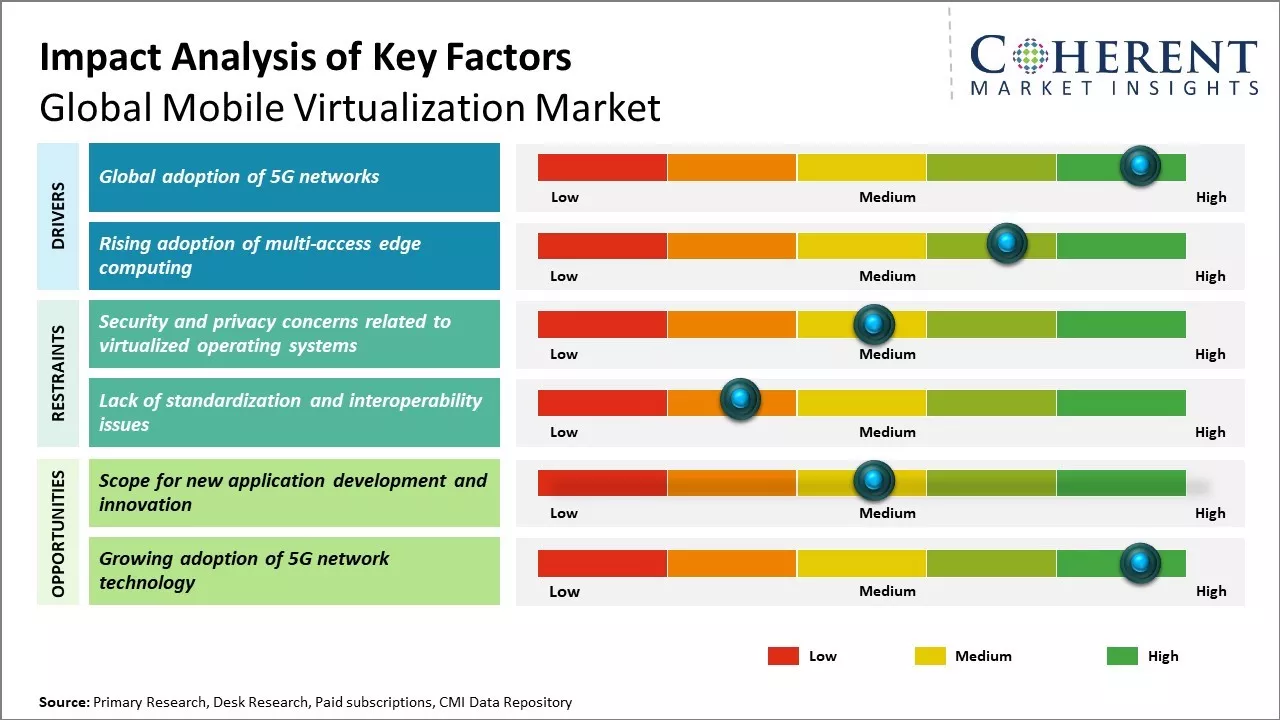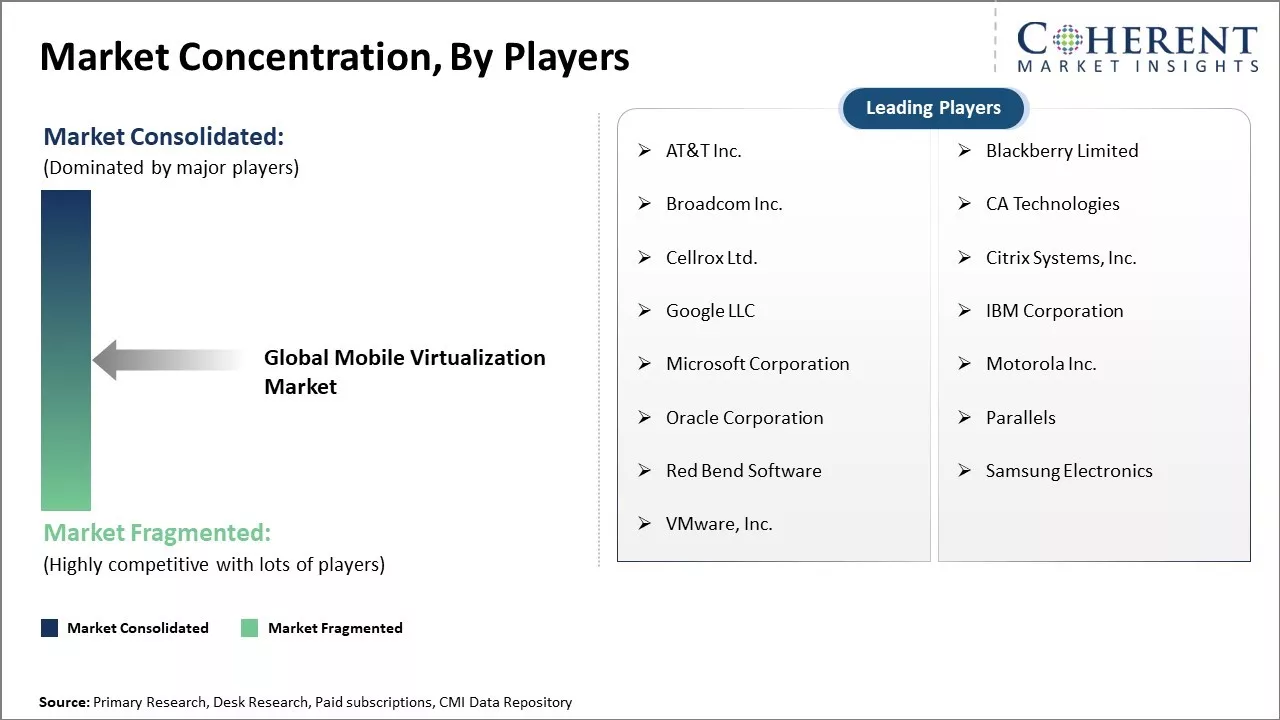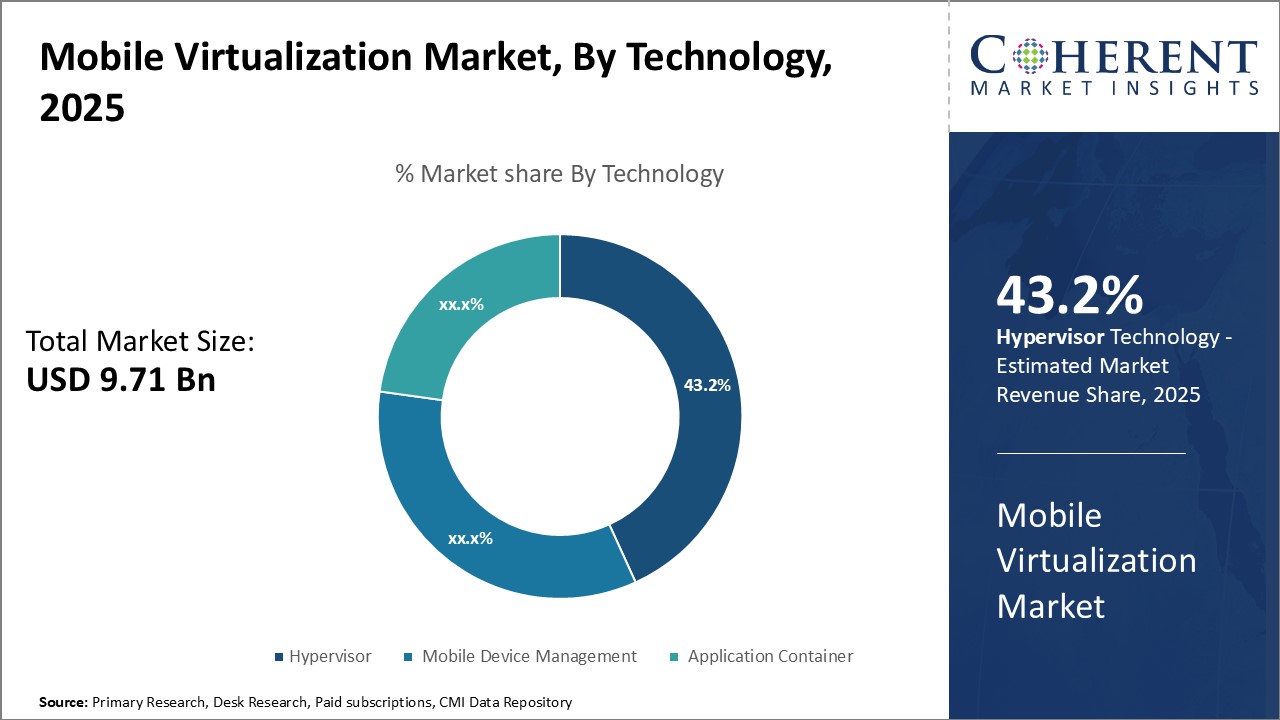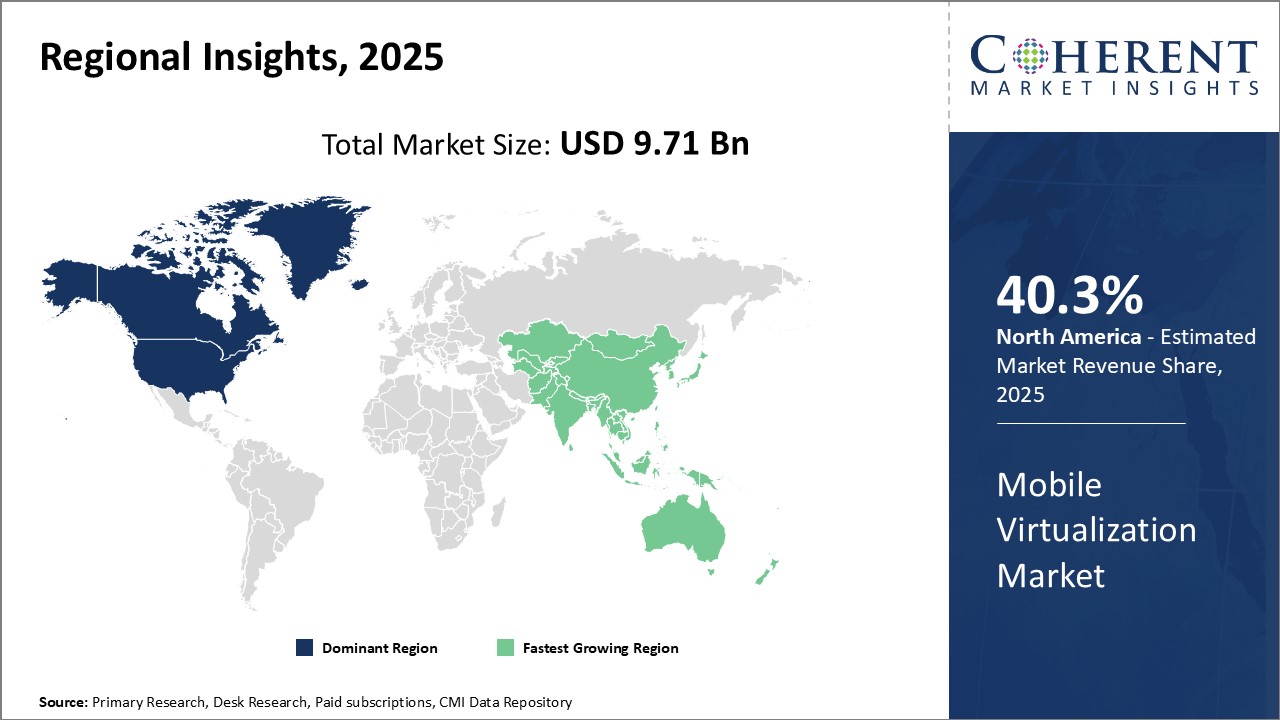Mobile Virtualization Market Size and Trends
The Global Mobile Virtualization Market is estimated to be valued at US$ 9.71 Bn in 2025 and is expected to reach US$ 36.88 Bn by 2032, exhibiting a compound annual growth rate (CAGR) of 21.0% from 2025 to 2032.

Discover market dynamics shaping the industry: Download Free Sample
The ability of mobile virtualization technology to consolidate multiple applications onto a single device and gain access through a single interface is supporting its growth. This capability provides advantages such as improved security and lower hardware costs by eliminating the need for separate physical devices. Additionally, the rising adoption of smart connected devices and growing popularity of digital applications is another key factor driving the demand. Enterprise mobility solutions providers are offering mobile virtualization to help companies securely access their business systems using personal devices. The growing need to secure company data and increasing bring your own device trends are further propelling the mobile virtualization market growth.
Drivers of the Market:
Global adoption of 5G networks
With 5G technology emerging at a rapid pace worldwide, it brings enormous potential for IT modernization and digital transformation. 5G offers vastly improved speed, capacity and responsiveness which unlocks new use cases that were not practical or possible before such as augmented and virtual reality applications, interactive and immersive digital experiences. As 5G networks build out globally, it will generate explosive growth in mobile data traffic volumes. This makes mobile virtualization and containerization increasingly important technologies for 5G network infrastructure and edge computing deployments. Mobile virtualization allows telcos and mobile operators to efficiently manage this traffic surge and provide flexible, on-demand network services. It helps optimize resource utilization, simplify operations and reduce costs of managing networks and applications at huge scale. Containerization further enhances these benefits by enabling lightweight, portable application packages that can be rapidly provisioned and relocated across base stations, central offices and data centers based on connectivity and usage demands. As 5G networks proliferate worldwide in the coming years, the need to deploy mobile virtualization and containerization will become integral to maximize the capabilities of 5G and monetize new opportunities it creates.
Market Concentration and Competitive Landscape

Get actionable strategies to beat competition: Download Free Sample
Rising adoption of multi-access edge computing
Edge computing is emerging as a fundamental architecture for 5G networks as it enables low latency services which are critical for applications like autonomous vehicles, telemedicine, augmented reality and IoT. Multi-access edge computing (MEC) provides an open platform at cellular base stations or other edge nodes to deploy disk and memory intensive applications and services closer to end users. This overcomes constraints of backhaul connectivity and reduces latency significantly. MEC is increasingly being adopted by mobile operators to offer localized services and customized experiences to subscribers. It also allows enterprises to deploy industrial IoT solutions and low-latency applications at network edges. As MEC gains widespread deployment supported by 5G infrastructure builds outs, mobile virtualization assumes high importance. It helps telcos and cloud/edge service providers to dynamically manage and optimize workload distribution across disparate edge locations based on real-time usage patterns. Mobile virtualization and containerization brings agility to deploy and update applications at any MEC server or base station on demand. This makes MEC infrastructure much more efficient, scalable and responsive to address differentiated demands of users, enterprises and vertical industry applications. Rising MEC adoption will propel the mobile virtualization market growth in coming years.
Key Takeaways from Analyst:
Drivers such as the increasing adoption of BYOD policies by enterprises and growing proliferation of smart connected devices are expected to boost the demand for mobile virtualization solutions. The ability of mobile virtualization to provide flexibility to enterprises for managing diverse mobile devices on a single platform will drive its adoption among organizations. Additionally, the need to ensure security of sensitive business data on personal devices is prompting companies to virtualize and isolate personal and work environments on mobile phones.
However, high initial investment and complexity of installing and maintaining mobile virtualization infrastructure may limit its adoption to some extent. Data privacy and security challenges of virtualizing on mobile phones can also act as a restraint for the market. Nevertheless, opportunities around leveraging mobile virtualization for enabling new mobile business models like DaaS (Desktop as a Service) are growing. Virtualizing graphic intensive applications on mobile devices is another avenue that solution providers are capitalizing on.
Geographically, North America currently dominates the mobile virtualization market owing to advanced IT infrastructure and high penetration of mobile devices among enterprises in the region. Asia Pacific is likely to showcase tremendous growth opportunities for mobile virtualization vendors during the forecast period. High mobile subscription and rising demand for mobility solutions from small and medium enterprises will drive the region's market growth.
Market Challenge: Security and privacy concerns related to virtualized operating systems
Security and privacy concerns related to virtualized operating systems have been one of the major restraining factors for the growth of the global mobile virtualization market. When an operating system is virtualized on a mobile device, all the applications, data, and settings reside in isolated virtual environments rather than directly on the actual hardware. While this allows increased flexibility and productivity, it also introduces new attack vectors for cybercriminals. Attackers can potentially gain access to entire virtual machines containing sensitive enterprise data if the virtualization platform has any vulnerabilities. They can then steal user credentials, intercept communications and exfiltrate valuable intellectual property quite easily.
These security risks have deterred many organizations, especially those in regulated industries like banking, healthcare and government, from fully embracing virtualization on employee-owned mobile devices. Mobile device management (MDM) and mobile application management (MAM) solutions have improved security in virtualized environments to some extent by allowing enterprises to lock down access and permission settings of virtual instances remotely. However, the layered security architecture brings added complexity and the possibility of oversight during configuration management. It also raises privacy concerns as enterprises have deeper levels of control over employees' personal devices through virtualization. Consumer users also tend to be more wary of virtualized environments due to the lack of transparency in how their data is protected across virtual machines and host operating systems.
Market Opportunities: Scope for new application development and innovation
Scope for new application development and innovation could present significant opportunities in the global mobile virtualization market. As mobile technologies continue to evolve at a rapid pace and user expectations increase, there is a pressing need for enterprises to create more engaging and personalized mobile experiences. Virtualization allows organizations to quickly develop and deploy innovative new applications that take advantage of the latest features of mobile devices, operating systems and networks. This enables enterprises to enhance their customer interactions, internal workflows and overall competitiveness in a dynamic business environment.
With mobile virtualization, applications can be simpler to develop and more easily ported across different mobile platforms. Using virtualization layers, developers can leverage common codebases and architectures to efficiently release apps targeted towards Android, iOS, and other operating systems. They no longer need to maintain separate and often duplicative code for each platform. This significantly reduces the cost and time involved in mobile app development cycles. It also makes it more feasible for enterprises to experiment with new app concepts and features without major additional investments. They can test market receptivity to new app ideas in a sandboxed virtual environment before committing to native development.

Discover high revenue pocket segments and roadmap to it: Download Free Sample
Insights By Technology - Technology Advancements Fuel Hypervisor Segment Growth
In terms of technology, the hypervisor segment is expected to hold 43.2% share of the market in 2025 owing to robust advancements in virtualization capabilities. Hypervisors allow multiple guest operating systems to run concurrently on a host device by partitioning the available hardware resources. This virtualization enhances functionality by enabling features such as on-device multi-OS usage and seamless OS switching. Ongoing hypervisor innovations such as improved hardware support, stronger isolation between guest systems, live migration abilities, and augmented security measures have made them the technology of choice for mobile virtualization. Major hypervisor vendors continually invest in optimizing virtualization performance to better utilize limited smartphone resources without impacting user experience. As mobile chipsets gain more processing power and mobile apps demand richer functionality, the need for robust virtualization architectures like hypervisors will further increase. This will provide the hypervisor segment an impetus to grow its market share in the coming years.
Insights By enterprise size - Large Enterprises Pave the Way in Enterprise Segment
In terms of enterprise size, the large enterprises segment is expected to hold 38.7% share of the market in 2025 owing to higher needs and capabilities. Large Enterprises often operate globally with a huge and diverse workforce relying on various devices, operating systems and applications. Mobile virtualization allows them to centrally manage this mobile ecosystem while keeping corporate data secure. Large Enterprises have the means to invest in advanced virtualization solutions and the scale to maximize returns. Moreover, they can afford customization and dedicated support from vendors. In contrast, small businesses have financial constraints and simpler requirements. Hence, large Enterprises spearhead mobile virtualization adoption to reap benefits like enhanced productivity, mobility, and reduced management overheads. Their leadership position will inspire growing virtualization adoption among small and medium players over time as solutions become more affordable.
Insights By End-use Industry - Entertainment Industry Embraces Mobility
In terms of End-use Industry, the media & entertainment segment is expected to hold 44.6% share of the market in 2025 owing to the nature of work. The entertainment industry is highly creative, collaborative and time-sensitive in nature. It relies heavily on mobile technologies to fuel innovations. Players in this sector use smartphones and tablets extensively for capturing content on location, editing videos remotely, streaming live performances, and more. Mobile virtualization allows convenient access to required applications, graphics-intensive editors, database of content from any device while maintaining security. It fosters faster content creation and delivery processes. Additionally, virtualization improves the fan experience through enhanced gaming and engaging virtual/augmented reality experiences. The growing expectations of digital audiences will spur greater mobility in the entertainment vertical, propelling the segmental growth.
Regional Insights

Need a Different Region or Segment? Download Free Sample
North America has emerged as the dominant region in the global mobile virtualization market. The region accounts for 40.3% of the market share in 2025, primarily driven by strong adoption of advanced technologies across various industry verticals in countries like the U.S. and Canada. The region is characterized by the presence of key technology giants and mature mobile ecosystem, enabling wide scale deployment of virtualization solutions. Mobile operators in North America are aggressively focusing on network optimization and upgrading infrastructure to embrace virtualization technologies.
Further, the growing trend of bring-your-own-device along with enterprise mobility has motivated organizations to explore virtualization tools to securely manage diverse mobile devices. Substantial R&D investments and government initiatives to develop innovative virtualization platforms are propelling the North America market. Countries in the region also have a well-established culture of startups and entrepreneurship, promoting development of niche virtualization vendors catering to various industry niches.
Among emerging regions, Asia Pacific market is expected to demonstrate the highest growth over the forecast period driven by mobile-first strategy of businesses across developing nations such as India, Indonesia and Vietnam. Rapid digitization and rising adoption of smartphones in the region are encouraging mobile operators to explore virtualization solutions that enable flexible usage of network resources and boost efficiency. Additionally, the region has emerged as global manufacturing hub prompting industries to leverage virtualization for optimized production planning using mobile devices.
Countries like China and South Korea are also at the forefront of 5G deployment and have robust virtualization infrastructure to meet future connectivity demands. Factors such as rising disposable incomes, increasing mobile internet penetration, and young demographic profile and expected to provide sustained impetus to the demand for virtualization platforms across Asia Pacific region going ahead.
Market Report Scope
Mobile Virtualization Market Report Coverage
| Report Coverage | Details | ||
|---|---|---|---|
| Base Year: | 2024 | Market Size in 2025: | USD 9.71 Bn |
| Historical Data for: | 2020 To 2024 | Forecast Period: | 2025 To 2032 |
| Forecast Period 2025 to 2032 CAGR: | 21.0% | 2032 Value Projection: | USD 36.88 Bn |
| Geographies covered: |
|
||
| Segments covered: |
|
||
| Companies covered: |
AT&T Inc., Blackberry Limited, Broadcom Inc., CA Technologies, Cellrox Ltd., Citrix Systems, Inc., Google LLC, IBM Corporation, Microsoft Corporation, Motorola Inc., Oracle Corporation, Parallels, Red Bend Software, Samsung Electronics, and VMware, Inc. |
||
| Growth Drivers: |
|
||
| Restraints & Challenges: |
|
||
Uncover macros and micros vetted on 75+ parameters: Get instant access to report
Mobile Virtualization Industry News
- In April 2023, V-Valley, a leading value-added distributor of products, services, and IT complex solutions, announced a partnership with StarWind Software, Inc., a Beverly, Massachusetts-based company specializing in storage virtualization and software-defined storage solutions. This strategic alliance will enable all V-Valley customers to access the catalog of products offered by StarWind, which includes all-flash hyper-convergence solutions.
- In October 2022, Microsoft, a leading technology company known for its productivity tools and mixed-reality technologies, and Meta, a global leader in digital payments and social media, collaborated to develop immersive experiences for the future of work and play. As declared during Meta Connect 2022, this collaboration allowed the integration of Mesh for Microsoft Teams on Meta Quest devices. This integration enables people to gather virtually where work happens on smartphones, laptops, and mixed-reality headsets.
- In August 2022, NetApp, a leading provider of data storage and management solutions, and VMware, a global leader in virtualization and cloud infrastructure, strengthened their partnership to support customers in their multi-cloud modernization endeavors. Through VMware Cloud Foundation with Tanzu, IT teams gain the capability to manage both virtual machines (VMs) and container orchestration from a unified platform. This collaboration also enables the utilization of NetApp ONTAP-based storage arrays, facilitating the creation of a flexible data fabric for traditional VMs and modern containerized applications. Together, these solutions empower organizations to simplify and accelerate new modern application development and deployment alongside traditional virtualized workloads using enterprise-scale, high-performance, and protected solutions that are jointly validated and supported.
*Definition: The Global Mobile Virtualization Market is a technology market focused on the virtualization of mobile devices and operating systems. It involves the partitioning of mobile resources and functions to run multiple operating systems concurrently on the same device. This allows developers to build and test apps across multiple platforms simultaneously, enhances enterprise mobility initiatives through improved security and management of BYOD/CYOD programs, and enables new form factors like foldable devices to run multiple UIs seamlessly. Mobile virtualization helps optimize hardware resources and enables innovative new mobile computing experiences.
Market Segmentation
- Technology Insights (Revenue, US$ Bn, 2020 - 2032)
- Hypervisor
- Mobile Device Management
- Application Container
- Enterprise Size Insights (Revenue, US$ Bn, 2020 - 2032)
- Large Enterprises
- Small & Medium Enterprises
- End-use Industry Insights (Revenue, US$ Bn, 2020 - 2032)
- Banking & Insurance
- Healthcare
- Media & Entertainment
- Retail
- IT & Telecom
- Others
- Regional Insights (Revenue, US$ Bn, 2020 - 2032)
- North America
- U.S.
- Canada
- Latin America
- Brazil
- Argentina
- Mexico
- Rest of Latin America
- Europe
- Germany
- U.K.
- Spain
- France
- Italy
- Russia
- Rest of Europe
- Asia Pacific
- China
- India
- Japan
- Australia
- South Korea
- ASEAN
- Rest of Asia Pacific
- Middle East & Africa
- GCC Countries
- Israel
- South Africa
- Rest of Middle East & Africa
- North America
- Key Players Insights
- AT&T Inc.
- Blackberry Limited
- Broadcom Inc.
- CA Technologies
- Cellrox Ltd.
- Citrix Systems, Inc.
- Google LLC
- IBM Corporation
- Microsoft Corporation
- Motorola Inc.
- Oracle Corporation
- Parallels
- Red Bend Software
- Samsung Electronics
- VMware, Inc.
Share
Share
About Author
Ankur Rai is a Research Consultant with over 5 years of experience in handling consulting and syndicated reports across diverse sectors. He manages consulting and market research projects centered on go-to-market strategy, opportunity analysis, competitive landscape, and market size estimation and forecasting. He also advises clients on identifying and targeting absolute opportunities to penetrate untapped markets.
Missing comfort of reading report in your local language? Find your preferred language :
Transform your Strategy with Exclusive Trending Reports :
Frequently Asked Questions
EXISTING CLIENTELE
Joining thousands of companies around the world committed to making the Excellent Business Solutions.
View All Our Clients
